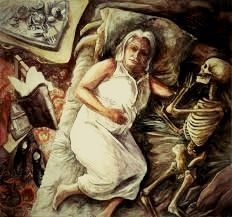Don’t explain, Lavender Scare of the 1950s, Marxist interpretation
Don’t
explain, Lavender Scare of the 1950s, Marxist interpretation
Don't Explain is a
story written by Gomez about the inner struggles of a gay woman, Letty is a black lesbian who chooses not to explain in
the face of social pressures and identity identification. This story not only
reflects the helplessness of being a sexual minority, but also the oppression
of capitalism in Marx's theory, and there is also such a period in history,
that is the gay purge in American politics. This article will combine Marx's
literary theory and related historical facts to analyze Letty's dilemma in
Don't Explain to explain individual identity and oppression under capitalism.
Letty faced oppression and discrimination
from society because of her black and gay identity. She is uneasy about her
identity because society sees her as someone at the bottom of society, whether
because of her race or sexual orientation. The idea of American capitalism
promotes the "American Dream" that if you work hard, you can succeed,
however, people like Letty, face all sorts of injustices and barriers to equal
opportunities. The capitalist concept of competition makes people in society
fall into relentless competition. Marxist theory states that our belief in the
American Dream leads us to ignore the reality that a large number of people,
including those who can afford it, have no or no equal opportunity in
education, employment, or housing due to factors such as gender, race,
religion, sexual orientation, gender identity, and socioeconomic class. Worse
still, the American Dream leads us to believe that the poor who are unable to
significantly improve their financial situation must be lazy and/, or otherwise
unworthy of decent living conditions. In contrast, those at the bottom of
society are often marginalized and ignored, which reflects class oppression in
the capitalist system.
At the same time, the pressures and fears
that Letty faced highlighted the social discrimination she faced as a black and
gay person. She fears violence and social exclusion, as social prejudice and
discrimination against these minorities make them more vulnerable and dangerous.
This is the same as the historical persecution and discrimination of gay groups
in the workplace, especially the "lavender scare" of the 50s of the
20th century when the US government purged the gay community from politics and
expelled them as "sexual perverts", as was the purge of communists.
There are some commonalities between
LGBTQ+ people and communists, mainly in the following ways:
First, they are both seen as subversive
threats: in the United States in the 50s of the 20th century, both LGBTQ+
identities and communists were identified by the government as a subversive
threat to the country. The government has pursued the two groups on the grounds
of "national security" and even banned them from government work.
Second, these two groups are implicated by the government: during the lavender
scare, the U.S. federal government fired LGBTQ+ federal employees in the name
of national security. Similarly, during the Red Scare, the government pursued
and fired those suspected of being associated with communism. Third, both
suffer from social discrimination: LGBTQ+ identities and communists are seen as
outliers in society and face unfair treatment and treatment. Fourth, these two
groups chose to stand up: in the face of government persecution and social
discrimination, both LGBTQ+ identities and Communists actively resisted and
struggled. They organized and spoke out for their rights and dignity, like
Frank Kamini, who led the decades-long struggle for gay rights.
The reason why these threats are threats
is related to the vicious competition of capitalism. Capitalism believes that
competition between individuals – competition for jobs, competition for salary
increases, competition for customers, competition for loans, competition for
rewards, and so on - is the best way to promote a strong society because
competition ensures that the most capable and intelligent people rise to the
top. Conversely, Marxist theory argues that unfettered competition is
oppressive because it tends to ensure that the most selfish and immoral people
rise to the top. After all, they are willing to win at all costs. As a result,
the needs of entire communities are often overlooked, and the needs of those
who are least willing or unable to compete are often sacrificed entirely.
All in all, while it may seem absurd to
compare LGBTQ+ identities to communists, it certainly proves the antagonism and
inequality of the capitalist underclass. Classism is a belief that our worth as
human beings is directly related to the social class to which we belong: the
higher our social class, the higher our natural or innate superiority. Similarly,
in the United States, those trapped in the lower classes are seen as inferior,
as if it were their fault. But it is precisely in this way that these two
groups can fight for their equality and dignity, which proves that where there
is oppression, there is resistance. In this historical context, Letty's story
illustrates the complex relationship between sexual minorities and social
oppression under capitalism. As Marxist theory emphasizes, her experience
reflects how the socioeconomic system in which we live shapes our identity. Not only can we feel at ease for Letty, because
perhaps shortly her "don't explain" won't be the stone in her heart,
but we can also gain a deeper understanding of the ills of capitalist society
and the importance of Marxism in explaining and critiquing this oppression.
Works Cited
Gomez, Jewelle. “Don’t Explain.” Using
Critical Theory, edited by Lois Tyson, Routledge, 2021, 354-361.
“Lavender Scare.” Wikipedia,
Wikimedia Foundation, 19 Feb. 2024, en.wikipedia.org/wiki/Lavender_Scare.
“What Was the Lavender Scare, and
Why Is It Not Well Known?” Quora,
www.quora.com/What-was-the-Lavender-Scare-and-why-is-it-not-well-known.
Accessed 20 Mar. 2024.







I liked it. You made some good points, especially when relating lavender scare to the red scare
ReplyDeleteI really enjoyed reading this; I think your conclusion summarizes everything very well. All the points that you made were relevant to your thesis, and your use of images helps make the blog even better.
ReplyDelete